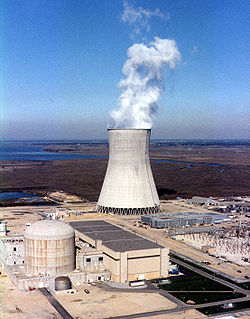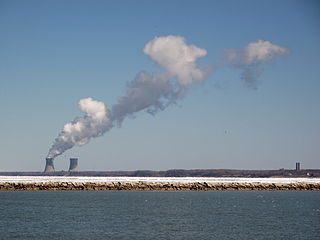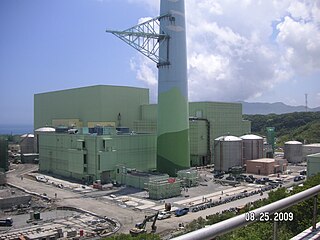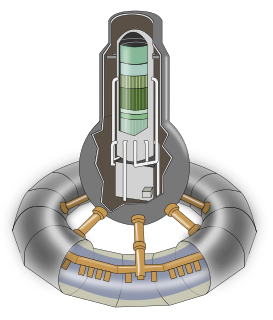
Fault tree analysis (FTA) is a top-down, deductive failure analysis in which an undesired state of a system is analyzed using Boolean logic to combine a series of lower-level events. This analysis method is mainly used in the fields of safety engineering and reliability engineering to understand how systems can fail, to identify the best ways to reduce risk or to determine event rates of a safety accident or a particular system level (functional) failure. FTA is used in the aerospace, nuclear power, chemical and process, pharmaceutical, petrochemical and other high-hazard industries; but is also used in fields as diverse as risk factor identification relating to social service system failure. FTA is also used in software engineering for debugging purposes and is closely related to cause-elimination technique used to detect bugs.

Hope Creek Nuclear Generating Station is a thermal nuclear power plant located in Lower Alloways Creek Township, in Salem County, New Jersey, United States, on the same site as the two-unit Salem Nuclear Power Plant. The plant is owned and operated by PSEG Nuclear LLC. It has one unit, a boiling water reactor (BWR) manufactured by GE. The complex was designed for two units, but the second unit was cancelled in 1981. It has a generating capacity of 1,268 MWe. The plant came online on July 25, 1986, licensed to operate until 2026. In 2009, PSEG applied for a 20-year license renewal, which it received in 2011. With its combined output of 3,572 megawatts, the Salem-Hope Creek complex is the largest nuclear generating facility in the Eastern United States and the second largest nationwide.

The Perry Nuclear Power Plant is located on a 1,100-acre (450 ha) site on Lake Erie, 40 miles (65 km) northeast of Cleveland in North Perry, Ohio, US. The nuclear power plant is owned by First Energy Nuclear Operating Corporation.

Surry Power Station is a nuclear power plant located in Surry County in southeastern Virginia, in the South Atlantic United States. The power station lies on an 840-acre (340 ha) site adjacent to the James River across from Jamestown, slightly upriver from Smithfield and Newport News. Surry is operated by Dominion Generation and owned by Dominion Resources, Inc.
Probabilistic risk assessment (PRA) is a systematic and comprehensive methodology to evaluate risks associated with a complex engineered technological entity or the effects of stressors on the environment for example.

A containment building, in its most common usage, is a reinforced steel or lead structure enclosing a nuclear reactor. It is designed, in any emergency, to contain the escape of radioactive steam or gas to a maximum pressure in the range of 275 to 550 kPa. The containment is the fourth and final barrier to radioactive release, the first being the fuel ceramic itself, the second being the metal fuel cladding tubes, the third being the reactor vessel and coolant system.

The advanced boiling water reactor (ABWR) is a Generation III boiling water reactor. The ABWR is currently offered by GE Hitachi Nuclear Energy (GEH) and Toshiba. The ABWR generates electrical power by using steam to power a turbine connected to a generator; the steam is boiled from water using heat generated by fission reactions within nuclear fuel. Kashiwazaki-Kariwa unit 6 is considered the first Generation III reactor in the world.

The Price-Anderson Nuclear Industries Indemnity Act is a United States federal law, first passed in 1957 and since renewed several times, which governs liability-related issues for all non-military nuclear facilities constructed in the United States before 2026. The main purpose of the Act is to partially compensate the nuclear industry against liability claims arising from nuclear incidents while still ensuring compensation coverage for the general public. The Act establishes a no fault insurance-type system in which the first approximately $12.6 billion is industry-funded as described in the Act. Any claims above the $12.6 billion would be covered by a Congressional mandate to retroactively increase nuclear utility liability or would be covered by the federal government. At the time of the Act's passing, it was considered necessary as an incentive for the private production of nuclear power — this was because electric utilities viewed the available liability coverage as inadequate.

The AP1000 is a nuclear power plant designed and sold by Westinghouse Electric Company. The plant is a pressurized water reactor with improved use of passive nuclear safety. The first AP1000 began operations in China at Sanmen Nuclear Power Station, where Unit 1 became the first AP1000 to achieve criticality in June 2018.
WASH-740 was a report published by the U.S. Atomic Energy Commission (USAEC) in 1957. This report, called "Theoretical Possibilities and Consequences of Major Accidents in Large Nuclear Power Plants", estimated maximum possible damage from a meltdown with no containment building at a large nuclear reactor.

The Economic Simplified Boiling Water Reactor (ESBWR) is a passively safe generation III+ reactor design derived from its predecessor, the Simplified Boiling Water Reactor (SBWR) and from the Advanced Boiling Water Reactor (ABWR). All are designs by GE Hitachi Nuclear Energy (GEH), and are based on previous Boiling Water Reactor designs.

Nuclear safety in the United States is governed by federal regulations issued by the Nuclear Regulatory Commission (NRC). The NRC regulates all nuclear plants and materials in the United States except for nuclear plants and materials controlled by the U.S. government, as well those powering naval vessels.

The McGuire Nuclear Station is a nuclear power plant located about 17 miles (27 km) northwest of Charlotte, North Carolina, on the state's largest lake, Lake Norman. It is a 32,500-acre (13,200 ha) lake created in 1963 by Duke Power for the Cowans Ford Hydroelectric Station. The McGuire units use the lake's water for cooling.
Core damage frequency (CDF) is a term used in probabilistic risk assessment (PRA) that indicates the likelihood of an accident that would cause severe damage to a nuclear fuel in nuclear reactor core. Core (severe) damage accidents are considered extremely serious because severe damage to the fuel in the core prevents adequate heat removal or even safe shutdown, which can lead to a nuclear meltdown. Some sources on CDF consider core (severe) damage and core meltdown to be the same thing, and different methods of measurement are used between industries and nations, so the primary value of the CDF number is in managing the risk of core accidents within a system and not necessarily to provide large-scale statistics.

General Electric's BWR product line of Boiling Water Reactors represents the designs of a large percentage of the commercial fission reactors around the world.

















